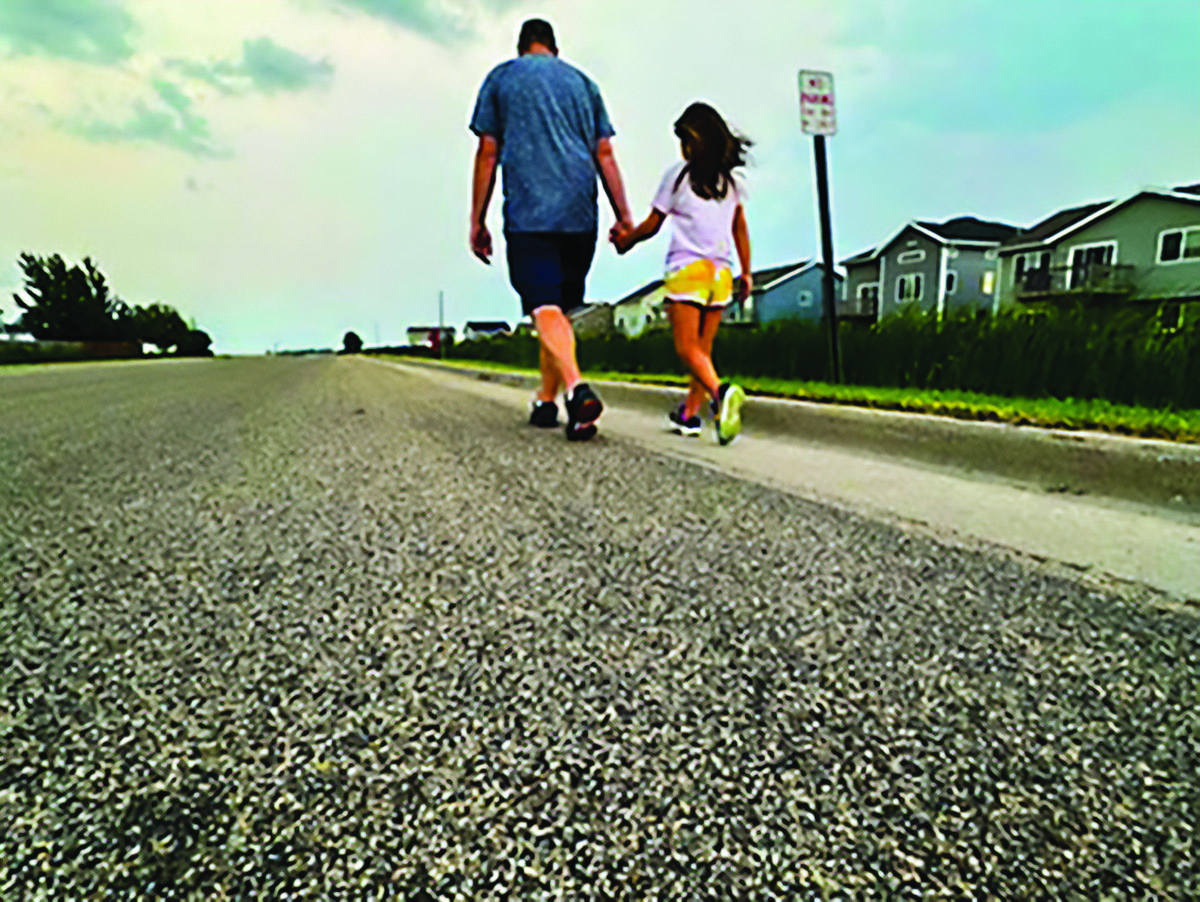
A father and daughter walk along the side in one of Moorhead’s sidewalk-less neighborhoods. (Photo/Patricia Vetter.)
Minnesota Pedestrian Statute (2023)
Rights in absence of signal: Where traffic-control signals are not in place or in operation, the driver of a vehicle shall stop to yield the right-of-way to a pedestrian crossing the roadway within a marked crosswalk or at an intersection with no marked crosswalk. The driver must remain stopped until the pedestrian has passed the lane in which the vehicle is stopped. No pedestrian shall suddenly leave a curb or other place of safety and walk or run into the path of a vehicle which is so close that it is impossible for the driver to yield. ce of safety and walk or run into the path of a vehicle which is so close that it is impossible for the driver to yield.
Walk on left side of roadway: Pedestrians when walking or moving in a wheelchair along a roadway shall, when practicable, walk or move on the left side of the roadway or its shoulder, giving way to oncoming traffic. Where sidewalks are provided and are accessible and usable, it shall be unlawful for any pedestrian to walk or move in a wheelchair along and upon an adjacent roadway.
Nancy Edmonds Hanson
Days like these are made for walking. From dawn to dusk, you’re likely to find Moorheaders treading the city’s streets and avenues – some leisurely strolling, others trudging to work or school, but all united in their use of the city’s residential byways.
Those pedestrian byways, though, vary greatly between neighborhoods. Homes built throughout much of the city’s past line traditional blocks defined by sidewalks. Young or old, those walking past are separated from the traffic by broad green boulevards.
Not so, however, in most areas developed between the 1970s and the late 1990s. Unlike its neighbors across the river, Moorhead’s 30- to 50-year-old developments frequently lack the ribbons of concrete that accommodate those traveling on foot. Navigating those areas frequently involves stepping out on the sloping margin of the street itself … alert for (often speeding) SUVs and pickups, as well as cars backing onto the street with their vision obscured by parked cars and landscaping.
That risky business is not so common now. According to city planner Kristie Leshovsky, housing developments built since 1997 have been required to include sidewalks in their plans.
“The city code has had provisions for sidewalks since 1997,” she says. “An ordinance passed in 1997 added language requiring sidewalks on one side of local streets. In 2002, it was changed to require them on both sides of the street in new developments.”
The rules came at the end of almost 50 years in which Moorhead home owners – like others all across the nation – leaned toward the suburban dream of broad swaths of perfect green lawns unbroken by concrete pathways. As America idealized the automobile and a vision of privacy, public walkways fell out of favor.
“It used to be, if you lived in a city, you put in sidewalks – period,” assistant city engineer Tom Trowbridge observes. “That changed in the 1960s and ‘70s. People figured that foot traffic was so low that they could walk on the street, and everyone hates shoveling sidewalks.”
During the rapid growth of the 1960s, ‘70s and ‘80s, Leshovsky says, the decision was left up to developers. There was no standard. Based not only on buyer preferences but also the cost of laying the concrete, the answer was “no.”
Change came with the 1997 ordinance requiring sidewalks on one side of a new street, as in the Meadows development. Five years later, it was broadened to both sides, but with an exemption for cul de sacs. It was broadened to include them the next year. (Most of Moorhead’s 284 cul de sacs were developed before the rule change.)
The sidewalk ordinances, however, don’t apply to homes built before their passage. That leaves large swaths of residences on the north, east and south sides of the city with whatever builders chose – mostly uninterrupted lawns stretching out to the curb. Nevertheless, the street-side footage technically belongs to the city, just as it does in older areas with their familiar sidewalk-and-boulevard arrangement.
That has led to some improvements in Moorhead’s walkability. Trowbridge explains that street improvement projects offer an opportunity to rectify the sidewalk gaps. They can be added when other work is done in the area. The practice goes back more than 10 years: “If there isn’t a continuous path, adding them is our automatic default,” he explains. The Meadows and Brookdale developments are among areas where that’s been accomplished.
The priority is in areas where pedestrians especially need safe access – where children are walking to school or those on foot are connecting to bus stops and major thoroughfares, including the city’s network of trails.
Fitting sidewalks into spots where none were originally laid comes with some challenges beyond, of course, the cost involved. Short driveways are one of them. “You need about 20 feet of driveway to park a car outside,” the engineer explains. “If the garage isn’t far enough back from the public right of way, it can be a challenge. Parked cars can’t block the sidewalk.”
Engineers designing these project look for ways to work around the problem. They also avoid substantial barriers, including mature trees. And homeowners, too, get their say: When the addition of sidewalks is being considered, the engineering department contacts the neighborhood for comments.
“They welcome us putting in sidewalks a lot of the time,” Trowbridge reports. But the addition can sometimes be controversial. Homeowners along Belsly Boulevard and 35th Avenue west of 14th Street have organized and said no; the same thing happened on 19th Street North, where there are still large gaps in the existing sidewalks.
Sidewalk projects continue to be proposed wherever road construction is being considered. But isolated projects are unlikely. He notes, “Unfortunately, we don’t have a budget that lets us just go out and put them in. Working them in where we have street projects is the best that we can do. We try to meet everybody’s needs the best we can.”
The city does prioritize repairs to existing paths where broken concrete creates a tripping hazard, he adds. “We do keep an eye out for that, but we can’t be everywhere. If you see a tripping hazard, call Public Works and let them know.”
The big picture, Trowbridge and Leshovsky agree, strongly favors sidewalks. “Our roads aren’t just there for cars,” Trowbridge asserts. “They’re for everybody.”


